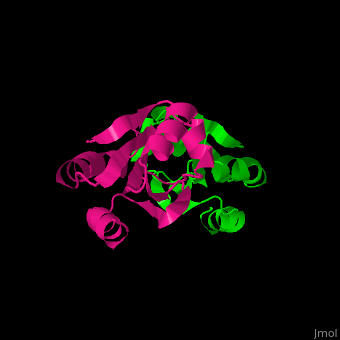Thioredoxin
From Proteopedia
(Difference between revisions)
| Line 7: | Line 7: | ||
* '''Trx C,M,X,Y''' are found in prokaryotes.<br /> | * '''Trx C,M,X,Y''' are found in prokaryotes.<br /> | ||
* '''Trx F,H,O''' are found in eukaryotes.<br /> | * '''Trx F,H,O''' are found in eukaryotes.<br /> | ||
| - | + | There are a range of strategies used by the host organism in an attempt to defend itself against pathogen invasion. Among these is the release of oxidants, such as reactive oxygen species (ROS), which at defined physiological concentrations act as signaling messengers. However, in supraphysiological concentrations, their reactivity has deleterious cellular consequences, causing damage to macromolecules such as proteins, lipids and DNA, thus impairing the system's homeostasis (SIES, 1985). It is therefore an alternative used to inhibit the pathogen and prevent infection of the organism. | |
| + | |||
== Relevance == | == Relevance == | ||
Revision as of 11:57, 23 June 2025
| |||||||||||
References
- ↑ Gleason FK, Holmgren A. Thioredoxin and related proteins in procaryotes. FEMS Microbiol Rev. 1988 Dec;4(4):271-97. PMID:3152490
- ↑ Sumida Y, Nakashima T, Yoh T, Furutani M, Hirohama A, Kakisaka Y, Nakajima Y, Ishikawa H, Mitsuyoshi H, Okanoue T, Kashima K, Nakamura H, Yodoi J. Serum thioredoxin levels as a predictor of steatohepatitis in patients with nonalcoholic fatty liver disease. J Hepatol. 2003 Jan;38(1):32-8. PMID:12480557
- ↑ Burke-Gaffney A, Callister ME, Nakamura H. Thioredoxin: friend or foe in human disease? Trends Pharmacol Sci. 2005 Aug;26(8):398-404. PMID:15990177 doi:http://dx.doi.org/10.1016/j.tips.2005.06.005
- ↑ Weichsel A, Gasdaska JR, Powis G, Montfort WR. Crystal structures of reduced, oxidized, and mutated human thioredoxins: evidence for a regulatory homodimer. Structure. 1996 Jun 15;4(6):735-51. PMID:8805557
Proteopedia Page Contributors and Editors (what is this?)
Michal Harel, Alexander Berchansky, Laura Maria Batista Leal, Joel L. Sussman

